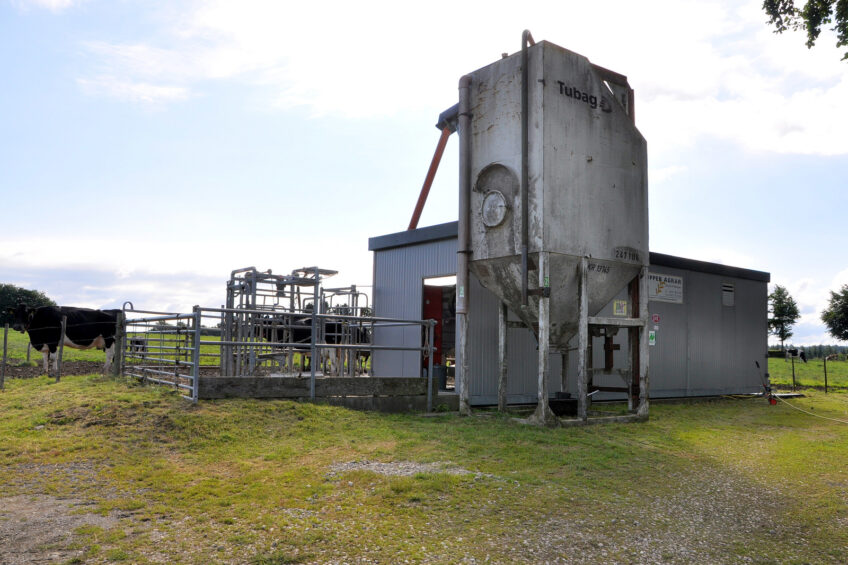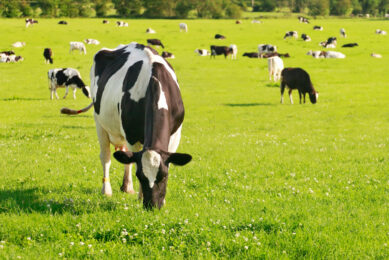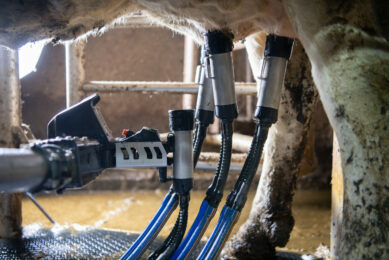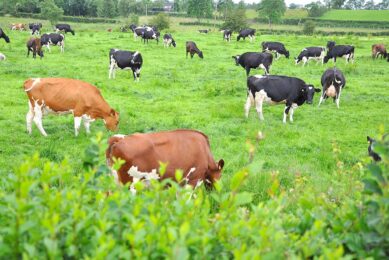A look at a milking robot in a German field

Anyone who walks cows along public roads taking them from parlour to pasture will concur how difficult this daily task can be. Back in 2009 a German dairy farmer took extraordinary steps to solve his own logistical problems by placing robotic milking units in his fields.
Markus Legge (53), farms in the deep west of Germany very close to the Belgian border and close to a picturesque tourist town called Monschau.
The area is full of little roads and quite a number of residences along the way, making it a huge logistical problem for Legge to take the cows to the fields after milking. The journey from parlour to pasture was less than one kilometre but it was a narrow road full of twists, turns and tourists.
Fond of crossbreeds
His solution was to install two Lely Astronaut robotic milking machines in his fields, becoming the first ever farmer in Germany to use this system.
Legge has been farming organically since 2001 and is currently milking 130 cows mainly of the Holstein Friesian breed using both black and white as well as red and white genetics. He is also very fond of crossing breeds to give him a more sustainable cow and uses Brown Swiss, Scandinavian Rotvieh and Montbeliarde to produce dairy followers. Semen from Belgian Blue and Simmentals bulls are used on second and third time inseminations to produce some beef calves for sale.
Taking cows to pasture takes too much time
It was back in 2008 that Legge took a trip to Switzerland and became convinced that robotic milking was the way forward for him. Markus said: “I have 80 hectares of land mostly in grassland and arranged in blocks, although there are some smaller fields that are on their own. “My problem was that taking the cows to the pastures was taking too long each day and night after milking.
“The roads here are narrow and bendy with a lot of residences along the way. None of the people want cows in their garden so it was a tough challenge each day. We had to use three of four people to guide the herd past all the houses without doing any damage. I saw the robots in Switzerland and thought the idea of installing them in my fields would cure my problem. But there were some logistical problems to solve including how to power the machines and how to make them portable,” he said.
2.5 milkings per day
With the help of the development team Legge was able to construct two secure and portable containers in which his two Lely robots were built along with a milk storage tank, a wash room and a small office. The units are powered by a 700m electricity cable and water is piped to the units for washing the robots. Water troughs for the cows are only placed at the robotic milking machines to entice them to come and be milked.
“The cows are milked on average two and a half times per day by the robots,” said Legge. “We split the herd in two and put them into two blocks each of 20 hectares. In the beginning of course we had some teething problems. The cows took a little longer to train to come to the units than normal. However, placing the only water supply for them at the milking station means they come there voluntarily to drink and to be milked. The robotic milking units remain in the fields from April through to October when they are then moved into the barns for Winter milking. It’s a simple enough task moving the units,” said Legge. Each container weighs eight tonnes. Everything is inside the containers and can be easily packed up to be moved by the machinery.
Legge continues: “We only have to move them twice per year as the cows use the same pasture blocks each year. When it’s the grazing season we do move the cows around the fields on a rotation basis allowing for four centimetres of grass growth before the cows change field. Poaching of the land does occur around the robots as the cows wait there to be milked and drink water. However, we do save on other areas of the fields being poached as we change those areas regularly.”
Would not work for everyone
Legge has invested €400,000 in this project which includes both robots and their containers. His goal is to pay back the loan within 15 years saving money on labour costs along the way. Right now, Legge is the main worker on the farm but says he spends 25 hours per week working there thanks to the robots. His wife also carries out some jobs as well as a part-time casual worker.
Legge currently receives €0.48 (£0.40) per litre for his organic milk which is costing him €0.32 (£0.27) per litre to produce. The current herd average is 7,500 litres per cow per year which has dropped from an average 10,000 litres in 2000, falling after becoming fully organic in 2001. His milk averages 4.2% Butterfat and 3.48% Protein. Legge has a supply contract for 75% of his milk produced but because of its organic status, his milk is in huge demand and is never refused.
He receives €170 per hectare from Brussels for his organic status and is a firm believer in the benefits of Germany being a member of the EU.
“Having the robots in the field is a good system for us but I know it would not work for everyone,” said Legge. “Our cows have to walk a maximum 600m from the robot to their pastures, even on the furthest rotation. Current milk prices for conventional milk are indeed quite low and farmers are certainly losing money. There is a huge oversupply of milk in Germany and this needs to be reduced to try and improve the overall dairy situation here,” he concluded.
Join 13,000+ subscribers
Subscribe to our newsletter to stay updated about all the need-to-know content in the dairy sector, two times a week.


















